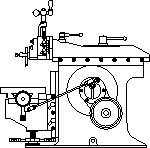

Deep in the wilderness far from civilization two old friends sit around a campfire discussing what? Politics? Religion? No, they were debating fundamental machine operations.
The old American says that any part can be machined by:
The gray haired gentleman from England admits that although making holes, turning rounds, and making flats are all that are required – all three operations can be performed adequately by a single machine – the lathe.
Here you see the fundamental difference between the philosophy of amateur machinists in the United States and their counterparts (Model Engineers) in the United Kingdom.
The amateur machinist's literature published in the past 50 years has been dominated by the excellent publications from England. Meanwhile the Americans, instead of building model locomotives, were falling in love with Hot Rods.
American involvement with steam engines was largely limited to the many farmers who lovingly maintained full-scale steam traction engines.
Disclaimer – for sure there were many excellent model locomotives made during this era and many excellent books and articles were written. But per capita the English contribution was much more significant.
The point of this is – the American industrial revolution and post war economic boom allowed hobbyists on this side of the pond to buy parts that the hobbyists in England were making in their basement.
Ten years ago most English amateur machinists did not have a milling machine and most American amateur machinists would argue that the English were doing things “the hard way”. The Americans took advantage of the fact that good used milling machines were becoming readily available from large manufacturing facilities which were upgrading to CNC (Computer Numeric Controlled) units.
Now – after so many years of communication and evolution, we see that the hobbyists in England are putting milling machines in their basement workshops and Americans are making more locomotives and fewer Hot Rods.
Something is missing here. What about shapers? During the early part of the 20th century, shapers played an important roll in machine shops and industry. With the widespread use of horizontal and vertical milling machines, most of the work that could previously be done on the shaper could now be done on the mill - much faster.
However, there were a few things that the old shapers could do better, and because of this they were frequently kept in industry long after they lost their ability to be cost effective in volume manufacture. After all, they were already paid for. Many stayed in shops until the last “old timer” that still knew how to run them retired. Even after retirement of the last shaper operator, they stayed in a dark corner of the shop waiting for a special job and collecting dust.
As a class of machines, they didn't have much value as used equipment for two reasons – size and knowledge. Most amateur machinists and many small machine shop operators didn't have a sufficient working knowledge of shaper capabilities to recognize any possible value. Also, unlike the retired old shaper operator, they didn't have a “Love for the machine”. As far as size, shapers are exponentially heavy as their size increases. The maximum length of cut they can take on their table commonly describes shapers. Whereas a 7-inch shaper weight in at 500 pounds, a 24-inch shaper will weigh over 2 tons. A 7-inch shaper might come with a one-half horsepower motor; a 24-inch shaper may have a ten horsepower motor.
But - things are changing. Used shapers are becoming more popular. On the used machinery market, the smaller shapers in the 5 to 9 inch range are becoming desirable and their prices are increasing. A few years ago, many were thrown out and scrapped. Even today, large shapers are scrapped because they are too heavy for amateurs and taking up valuable shop space.
Keep sending email with questions and interesting shaper stories.
My email address is KayPatFisher@gmail.com.